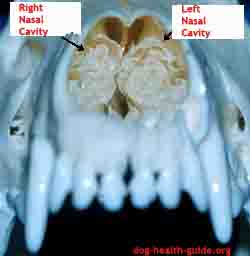Table of Contents
Overview | Diagnosis | Treatment | References
Overview
Dog stertor refers to a condition that causes symptoms such as occasional reverse sneezing or snorting (stertorous breathing). Sounds produced can resemble snoring. Breathing will sound rapid with bursts of air through the nose. It is thought that the condition is the body's attempt to move matter through the nasal cavity (from the nasopharynx to the oropharynx). Once in the mouth it can be swallowed by the dog.

Source: Washington State University
It is common for dogs brought to the veterinarian to not have the symptom at the time of the Veterinary visit. To aid diagnosis, record the sounds of your dog "reverse sneezing" and breathing using a smart-phone or other recording device. Play the recording for the veterinarian.The condition is caused by some type of partial obstruction in the dog's upper airway such as a foreign object such as a blade of grass, chronic infection or in rare cases, a nasal tumor.
Diagnosis
A veterinarian will examine the nasal cavity with emphasis on the nasopharynx (the nose cavity). Dogs will need to be sedated in order to conduct the examination. A vet will insert an endoscope into the nasal cavity in order to visualize the nasopharynx and the top of the dog's palate. Two x-rays of the thorax (right lateral and ventral) might also e needed.
In most cases, reverse sneezing or snorting in dogs is caused by a foreign object such as a piece of grass or twig being caught in the nose. Other commonly found objects are cotton balls, small pieces of food such as peas or thread. Less common are problems such as the presence of a tumor.
Treatment
Once the problem is identified, a veterinarian will use the appropriate medical or surgical intervention to remove an object or treat a lesion. Most cases can be successfully cured.
References
DIAGNOSIS AND THERAPY OF UPPER AIRWAY DISEASE
Philip Padrid, DVM
Family Pet Animal Hospital
The patient with thoracic effusion:
presentation and first aid, clinical assessment,
oxygen therapy, thoracocentesis
and thoracic drainage
Gary W. Ellison
DVM, MS, Dipl ACVS, Florida, USA
Researched by: Jeff Grill
